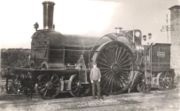
James Pearson (engineer)
Encyclopedia

James Pearson
James Pearson VC was an Irish recipient of the Victoria Cross, the highest and most prestigious award for gallantry in the face of the enemy that can be awarded to British and Commonwealth forces....
.
James Pearson was a 19th century English
England
England is a country that is part of the United Kingdom. It shares land borders with Scotland to the north and Wales to the west; the Irish Sea is to the north west, the Celtic Sea to the south west, with the North Sea to the east and the English Channel to the south separating it from continental...
railway engineer. He is best remembered as the designer of the distinctive Bristol and Exeter Railway 4-2-4T locomotives
Bristol and Exeter Railway 4-2-4T locomotives
The 14 Bristol and Exeter Railway 4-2-4T locomotives were broad gauge 4-2-4T steam locomotives built to three different designs. The first entered service in 1853...
.
South Devon Railway
James Pearson was the engineer responsible for the daily operations of Isambard Kingdom BrunelIsambard Kingdom Brunel
Isambard Kingdom Brunel, FRS , was a British civil engineer who built bridges and dockyards including the construction of the first major British railway, the Great Western Railway; a series of steamships, including the first propeller-driven transatlantic steamship; and numerous important bridges...
's ill-fated atmospheric
Atmospheric railway
An atmospheric railway uses air pressure to provide power for propulsion. In one plan a pneumatic tube is laid between the rails, with a piston running in it suspended from the train through a sealable slot in the top of the tube. Alternatively, the whole tunnel may be the pneumatic tube with the...
equipment on the South Devon Railway
South Devon Railway
South Devon Railway could mean:* South Devon Railway Company - the company that built the railway from Exeter to Plymouth* South Devon Railway Trust - the heritage railway from Totnes to BuckfastleighOther heritage railways in South Devon include:...
. Trains only ran in service from 13 September 1847 to 9 September 1848, but he was retained while the equipment was disposed of.
Bristol and Exeter Railway
In May 1850 he became the Bristol and Exeter RailwayBristol and Exeter Railway
The Bristol & Exeter Railway was a railway company formed to connect Bristol and Exeter.The company's head office was situated outside their Bristol station...
's Locomotive Engineer. Under his control the railway set up new locomotive works at Bristol Temple Meads
Bristol Temple Meads railway station
Bristol Temple Meads railway station is the oldest and largest railway station in Bristol, England. It is an important transport hub for public transport in Bristol, with bus services to various parts of the city and surrounding districts, and a ferry service to the city centre in addition to the...
. These opened in 1851 and built most of the railway's new broad gauge
Broad gauge
Broad-gauge railways use a track gauge greater than the standard gauge of .- List :For list see: List of broad gauges, by gauge and country- History :...
locomotives from 1859.
Locomotives designs
The most significant locomotives designed by James Pearson were:- 1851 Bristol and Exeter Railway 2-2-2T locomotivesBristol and Exeter Railway 2-2-2T locomotivesThe seven Bristol and Exeter Railway 2-2-2T locomotives were small 2-2-2 well tank locomotives designed by James Pearson for working branch lines such as those to Tiverton and Clevedon...
– 7 small tank locomotives - 1854 Bristol and Exeter Railway 4-2-4T locomotives – 8 locomotives with 9 feet wheels
- 1855 Bristol and Exeter Railway 4-4-0ST locomotivesBristol and Exeter Railway 4-4-0T locomotivesThe 26 Bristol and Exeter Railway 4-4-0ST locomotives were broad gauge 4-4-0 saddle tank steam locomotives. They first entered service in 1855 and the last was withdrawn in 1892...
– 26 saddle tank locomotives - 1856 Bristol and Exeter Railway 0-6-0 locomotives – 6 goods locomotives
- 1859 Bristol and Exeter Railway 4-2-4T locomotives – 2 locomotives with 7 feet 6 inch wheels
- 1868 Bristol and Exeter Railway 4-2-4T locomotives – 4 locomotives with 8 feet 10 inch wheels
- 1870 Bristol and Exeter Railway 2-4-0 locomotives – 10 passenger locomotives
- 1874 Bristol and Exeter Railway 2-4-0 locomotives – 3 convertible passenger locomotives

